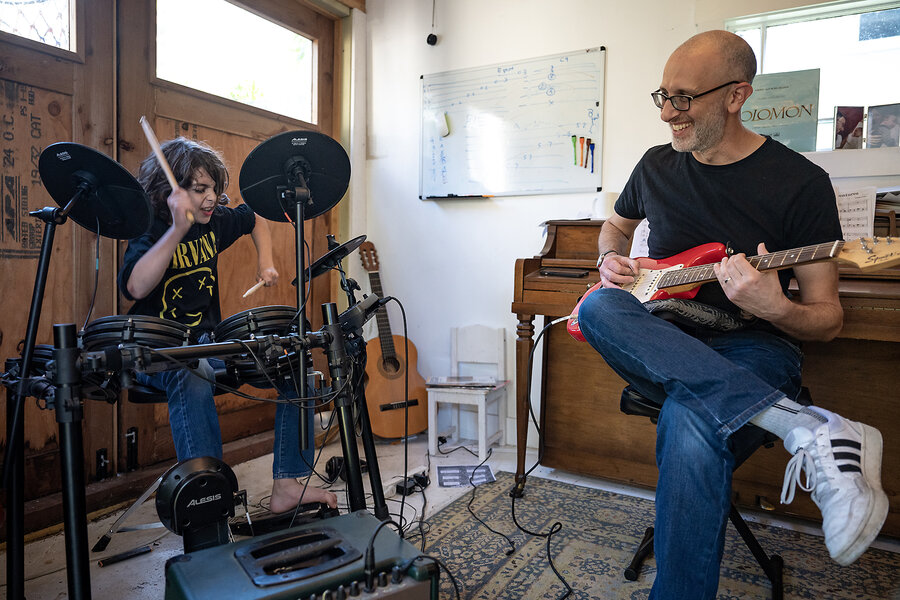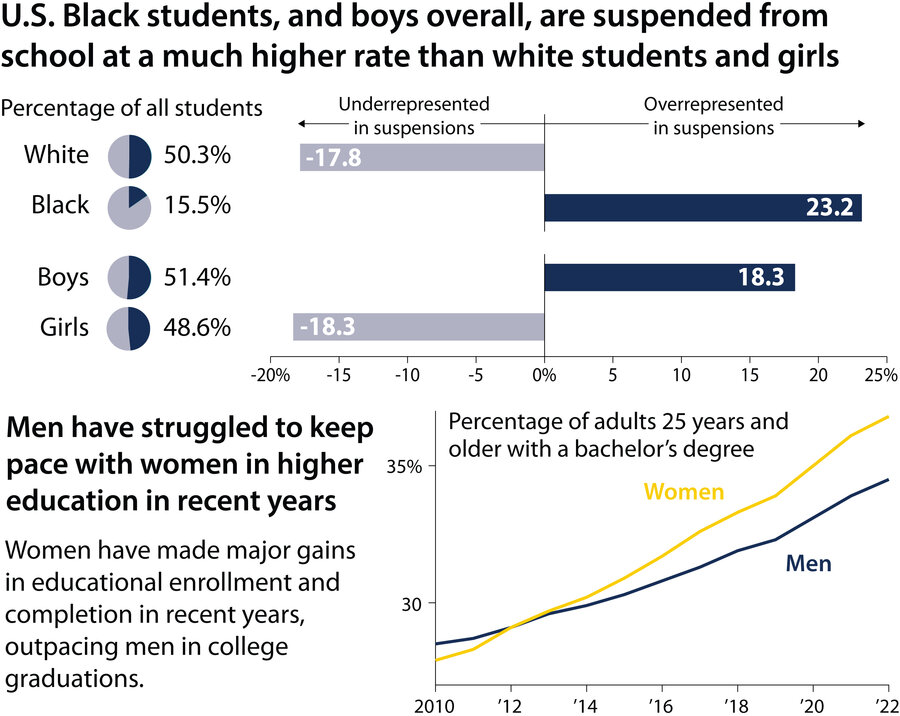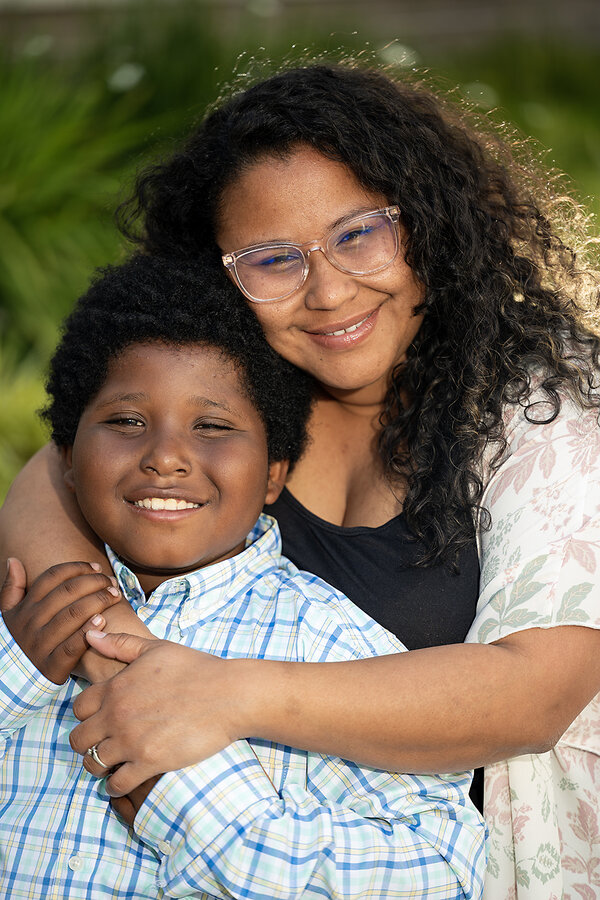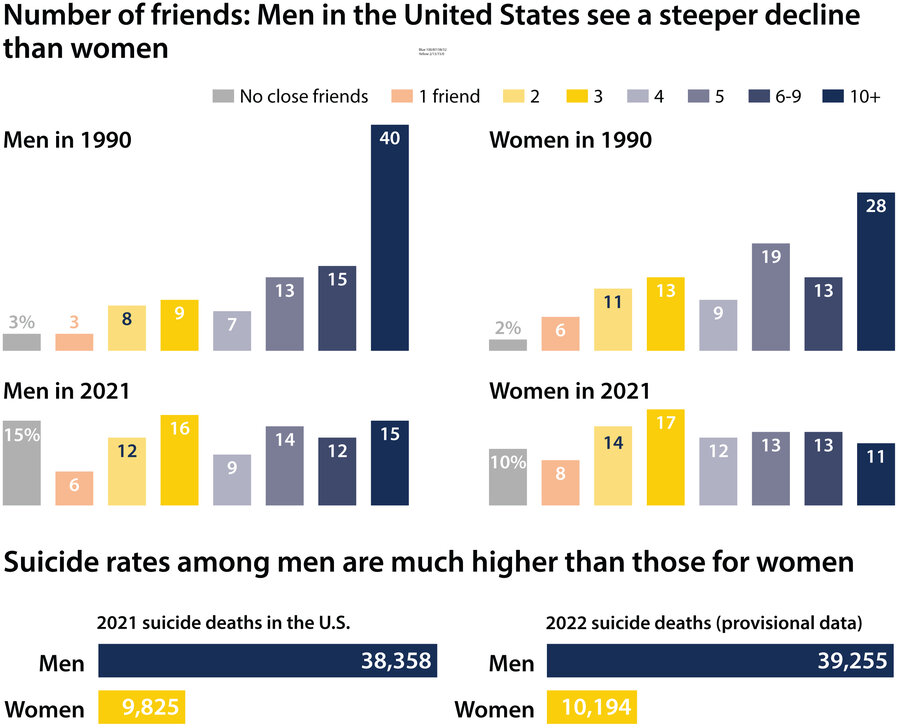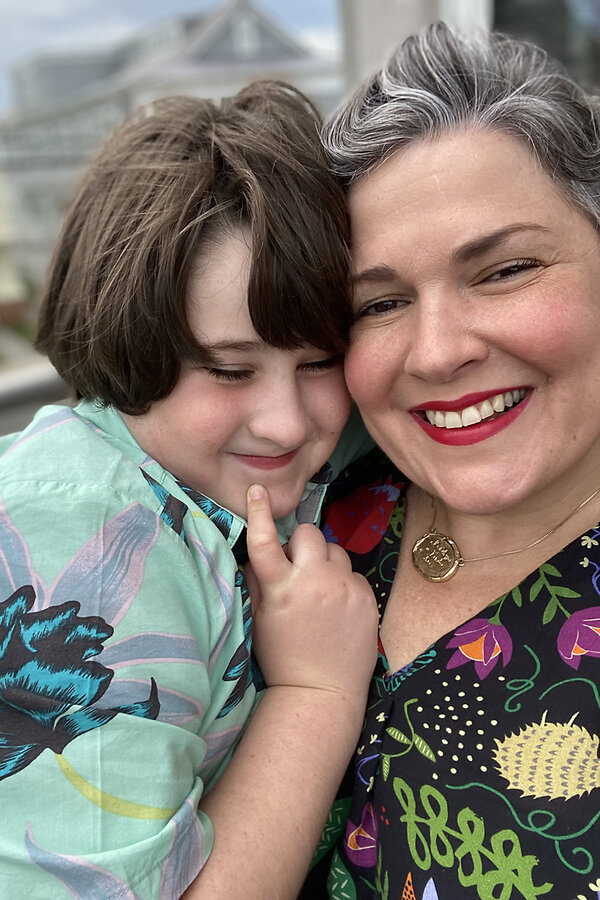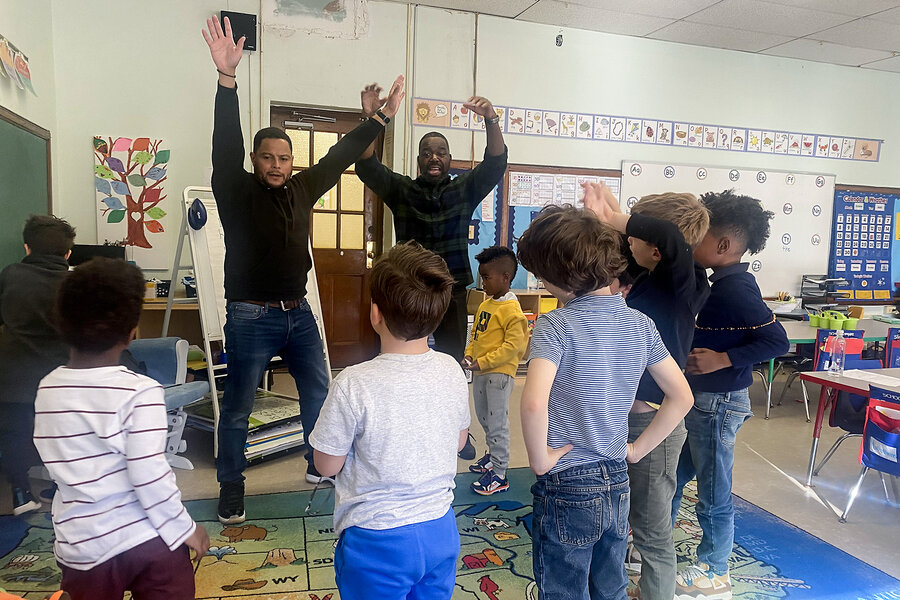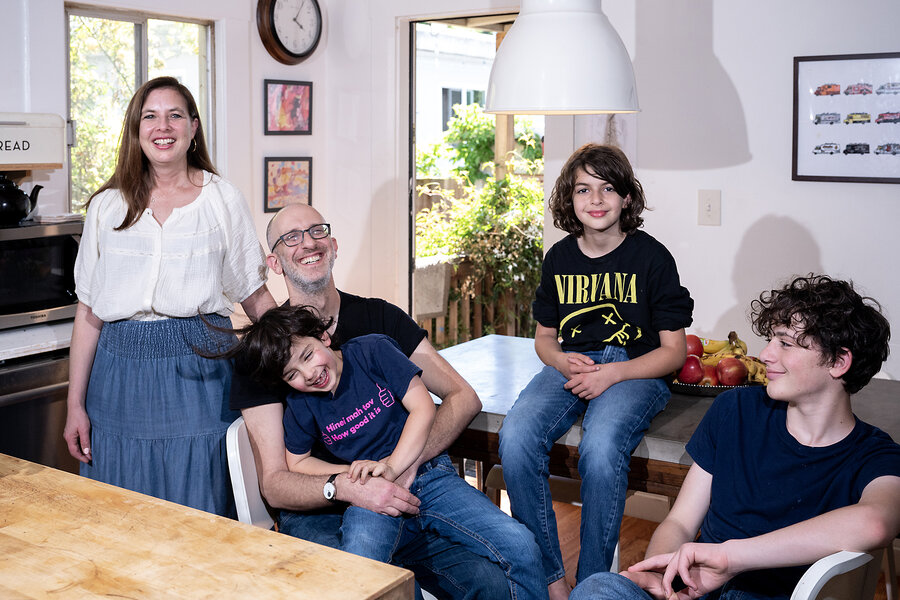Want to combat male loneliness? Start by helping boys connect with their emotions.
Loading...
When a preschool teacher told her 2-year-old son that she “liked him more when he didn’t cry,” Kimmi Berlin was worried.
She and her then-husband had been trying to raise their children outside the stereotypical gender norms they had grown up with. But they were stumped. “We knew the old scripts didn’t work, but we didn’t even know what the new scripts were,” she says.
Why We Wrote This
A story focused onBoys are expected to be tough and independent. But society’s emphasis on these qualities can leave them feeling adrift and alone. Parents and educators are finding ways to help boys cultivate emotional connections.
They asked the teacher to encourage their son’s full range of emotion, but they also craved a more collective solution.
That’s when Ms. Berlin decided to create Build Up Boys, an organization in Montclair, New Jersey, that trains educators and caregivers to help boys “preserve their innate emotional intelligence.”
In recent years, such countercultural programming has taken root in communities around the United States. The strategies are varied, but these efforts share one key goal: foster emotional supports for boys.
In Boston, Charles Daniels Jr., a therapist, focuses on fathers. His clinic is bustling with men who have committed to working on their mental health in order to show up for their children more consistently.
“Fathers are oxygen,” he says. “You need them to breathe freely as a boy, to understand what you can become.”
In a crowded coffee shop on Telegraph Avenue in Oakland, California, Ruth Whippman spots a group of men in their 60s and 70s at a nearby table. They’re sipping tea and chatting, and one of them gently pats the golden retriever at his feet. Another gives a hearty hug to a new man who walks in to join them.
Ms. Whippman is struck by the serendipity. Here she is, talking about her forthcoming book, “BoyMom: Reimagining Boyhood in the Age of Impossible Masculinity,” a meditation on the loneliness, conflict, and isolation that so many boys and men face. This group of guys nearby is enacting what Ms. Whippman argues is one essential solution to male loneliness: participation in intimate, authentic relationships.
The statistics are startling: Boys are falling behind in school, dropping out, and struggling to get into college and stay there. Even those who do face increasing mental health challenges. Boys today are more violent, more addicted to screen time, more lonely, and more likely to die by suicide than girls are. Even as the public conversation continues to bust out of the binary and talk more about the spectrum of gender, it seems that many boys are flailing.
Why We Wrote This
A story focused onBoys are expected to be tough and independent. But society’s emphasis on these qualities can leave them feeling adrift and alone. Parents and educators are finding ways to help boys cultivate emotional connections.
Ms. Whippman is so invested in the topic because she’s the mother of three boys. She remembers being pregnant with her third child in 2017, tossing and turning in bed, worrying about the typical litany of things one worries about when on the precipice of giving birth: Would she be safe? Would she have enough time and energy? Would she ever sleep again?
But she was also kept awake by a different set of fears, intensified by the daily deluge of bad male behavior just as #MeToo was going viral. As Ms. Whippman describes it in “BoyMom,” she had “a ticker tape of bad outcomes” for her unborn boy, including “interrupter, mansplainer ... birthday forgetter, frat boy, dude-bro, homophobe, self-important stoner, emotional-labor abstainer, nonwiper of kitchen counters.”
That was seven years ago. And from the looks of things, many experts say, the crisis of masculinity has only gotten worse.
What are we to make of the increasingly perilous place of boys in American society? Without taking anything away from the gains made by girls, can we find a way to provide better support for boys?
A growing chorus of journalists, psychologists, and advocates is helping paint a picture of the ways in which having empathy for the struggles of boys and men is not separate from the feminist project, but in fact essential to it.
Ms. Whippman is one of them. After the long, dark nights of her third pregnancy, she decided to report and write a book on how to find solutions. Her research took her from a residential center in southern Utah to an elite private school in Manhattan, and from the dark web – with its online misogyny – to her own living room, where her three bright sons alternated between ferocious wrestling and nearly comatose screen time. Her conclusion?
Boys are having to navigate a society that “overvalues power and undervalues intimacy and the expression of emotions,” she writes. Talking about harm to boys because of stereotypes about masculinity “is a different conversation from the ‘men are the real victims’ chest-beating of the [political] right,” she continues. “But at some deep level, in this system, men get everything except the thing that’s most worth having – human intimacy.”
Charles Daniels Jr., a therapist in Boston, agrees with Ms. Whippman’s conclusion. He adds a powerful racial angle to the struggle that boys are facing. Dr. Daniels opened what is thought to be the United States’ first mental health and addiction treatment facility specifically geared to fathers and families, called Fathers’ UpLift, in 2012.
He grew up hungering for his own father, who was unpredictable and unavailable. As he got older, the absence of a male role model grew even more painful.
“When I was younger, I was cute,” he says. “When I got older, I became a threat in the eyes of others. To feel that you’re perceived as a threat – in school, walking down the street – it eats you alive. It’s soul-sucking. It’s draining. It’s anxiety-producing. It etches away from the love that you have for yourself.”
Dr. Daniels felt that if he’d had a present, reliable, and emotionally vulnerable father around, things would have been different.
“Fathers are oxygen,” he says. “You need them to breathe freely as a boy, to understand what you can become.”
Every day his clinic is bustling with this possibility – men who have committed to working on their mental health in order to show up for their children more consistently. Fathers’ UpLift offers therapy, coaching, and organized retreats. It also increasingly offers youth programming to ensure that members of the next generation are getting what they need during their fathers’ personal development journeys.
“The antidote is relational, no question,” Dr. Daniels says. “We ask ourselves, ‘Are we being loving? Are we being caring?’ Black boys and men need that more than ever.”
They also need coaches and therapists who look like them. According to the American Psychological Association, over 80% of the psychological workforce is white and nearly 70% is female. To that end, Dr. Daniels has recently created a fellowship to recruit men of color into the mental health and addiction recovery professions.
There is a similar dearth of male educators in American schools – another obstacle to boys learning how to be relational and emotionally literate. According to the most recent data from the National Center for Education Statistics, only 11% of elementary school teachers are men and, of those, only 20% are nonwhite.
Black male teachers are in short supply. In the 2020-21 school year, for instance, only 1.3% of public school teachers were Black men.
On a recent morning at Emerson Elementary, a Black-majority public school in Oakland’s Temescal neighborhood, the auditorium was packed with parents, grandparents, aunts, uncles, and siblings. Some sat on chairs, many leaned against walls, and most held cellphones at the ready to capture the long-awaited performance on the stage.
They have come for the Black Excellence Showcase, an annual tradition at the school that integrates the Oakland Unified School District’s African American Male Achievement program (AAMA). The program is built around establishing culturally resonant role models. They provide what they call “king care,” helping Black youths and their families thrive.
The event came to vibrant life during the moment in which each of the boys approached the microphone and read a quotation from a notable Black figure that resonated with them personally.
One third grader stepped to the mic and said, “I am no longer accepting the things I cannot change. I am changing the things I cannot accept. Angela Davis.”
The crowd went wild. Tyler Hughes, who runs the AAMA program at two elementary schools, including Emerson, explains, “We used that moment as an opportunity to teach leadership. I’d say, we’re not just reciting quotations. We’re also learning public speaking, how to control our bodies, how to accomplish something together.”
AAMA facilitators conduct a range of activities with the boys, depending on their age. In elementary school, they get pulled out for small-group work using a curriculum called Khepra – an ancient Egyptian word that connotes transformation. It’s focused on “becoming our better selves,” says Mr. Hughes.
Amber Brown’s fourth grade son, Joseph – known as JoJo by his friends – is also in the AAMA program. Ms. Brown is an inexhaustible social force at the school – the one who festooned the auditorium with pink, red, and white balloons for the Valentine’s dance, coordinated the bake sale fundraiser for the fourth grade field trip, and DJed the annual community dinner, getting everyone out on the dance floor for “Cha Cha Slide.”
She’s also the chair of the School Site Council, which looks at the school’s test scores and plans the budget each year according to which students need the most support.
Black male students at Emerson are consistently among those who are furthest behind. As of last fall, only nine out of the 58 boys at Emerson were reading at or above grade level and only two were performing at or above grade level on math.
That’s part of why Ms. Brown so appreciates the school district’s program for boys. Its philosophy is that academic excellence is built on top of mental and cultural health. Ms. Brown says, “It’s beneficial for the young kings. The program fills in the gaps that allow our boys to see their full potential and step into their greatness.”
JoJo, known among his classmates for his short stature, sweet disposition, and ability to do full splits, says he likes being part of the program’s activities, too. Why? “Because I like the people. And they believe in me.”
Facilitators do home visits, look at students’ transcripts, take them out to lunch for one-on-one conversations, and even meet with their academic counselors and teachers – whatever it takes to make sure they’re on track for graduation. “We try to make sure these boys have no regrets, that they get to be proud of themselves for not just calling themselves kings, but really acting like kings, showing kingship,” Mr. Hughes says.
The Oakland Unified School District was the first in the U.S. to create a department that specifically addresses the needs of Black male students. (It also has a sister program – African American Female Achievement.)
That perspective strikes a chord with Dena Simmons, the founder of LiberatED and an expert in social-emotional learning. She wrote her dissertation on bullying and has spent the last 14 years teaching the importance of helping children express what they are authentically feeling.
Dr. Simmons urges an approach that recognizes not only the individual child but also other factors, such as the culture and climate of schools, households, and neighborhoods. “We can’t be emotionally intelligent without being culturally responsive. It’s imperative that we affirm our students’ identities and lived experiences,” she argues. “We must invite them to be partners in their own education, and center racial and social justice and healing.”
This contextual approach is echoed in investigative journalist Emma Brown’s 2022 book, “To Raise a Boy: Classrooms, Locker Rooms, Bedrooms, and the Hidden Struggles of American Boyhood.” She writes, “While boys’ parents undeniably play a critical role in shaping their attitudes and beliefs and behaviors, so do the boys around them – the teammates and classmates and upperclassmen who define what is cool and decide who belongs. Raising boys differently means thinking beyond how we are raising our individual sons to how we are giving boys collective space to create a different kind of boyhood.”
That is just what Kimmi Berlin, a writer and mother of two in Montclair, New Jersey, is trying to do. When she had children with her then-husband, a stand-up comedian, she really wanted to raise them outside the antiquated gender norms she had been given as a girl. But she and her husband were stumped. “We knew the old scripts didn’t work, but we didn’t even know what the new scripts were,” she says.
When their 2-year-old son was told by a preschool teacher that she “liked him more when he didn’t cry,” they were worried. They asked her to encourage their son’s full range of emotion, but they also craved a more collective solution.
That’s when Ms. Berlin decided to create Build Up Boys, an organization that trains educators and caregivers how to help boys “preserve their innate emotional intelligence,” working with young boys directly.
Unlike many interventions in this space, Build Up Boys believes that this kind of countercultural programming needs to start early. “The research tells us, boys start trading their humanity for social currency as early as 5 years old,” Ms. Berlin explains. “We have to give them permission to hold on to themselves.”
Ms. Berlin is referring to the seminal research of Dr. Judy Y. Chu, who conducted a two-year study in 2014 that followed boys from prekindergarten through first grade. She found that they lost their early abilities to be emotionally responsive in relationships when they read cultural cues that labeled these “feminine” qualities. New York University professor Niobe Way also named this a “crisis of connection” in her 2013 book, “Deep Secrets,” which focused on older boys around age 16.
“A range of studies confirm ... that the more closely men and boys conform to traditional masculine norms, the more likely they are to be depressed or suicidal,” reports “BoyMom” author Ms. Whippman. They are also more likely “to perform poorly in school and to engage in risky and unhealthful behaviors” while also being less likely to seek mental and physical health care.
Ms. Berlin, who has a background in theater, used this research as a jumping-off point to design a play-based curriculum for young boys. One example is a reimagined game of the old standby Red Light, Green Light. Boys pair up and take turns controlling the distance. The goal is to pay attention to their bodies and how it feels not to be in control and then put words to the experience. Ms. Berlin says, “Maybe you’re paired up with a kid who is sensory-seeking, and he doesn’t mind you getting very close. And maybe the other kid is sensory-avoidant, and getting close feels scary and he hates it. We learn to say that out loud with granular emotional vocabulary.”
After one recent workshop, a participant went home and told his mom that he didn’t like being kissed on the mouth by her – something he’d never been able to articulate before. “That felt huge,” Ms. Berlin explains. “If a 7-year-old boy can learn to feel his own boundaries and say them out loud now, when he reaches puberty, he will be so much more likely to respect other people’s boundaries – sexual and otherwise.”
Which gets back to Ms. Whippman’s deep fears about her own sons. She doesn’t want them to be harmed, and she doesn’t want them to cause harm as they grow into men. Her oldest son, Solly, was just bar mitzvahed – a Jewish coming-of-age ritual. “It was a moment to bring everyone together,” he says. “My dad had one. My grandpa had one. You dedicate yourself to this one thing, and you’re nervous, but you look out and see everyone, and you know that even if you mess up, they won’t criticize you. When it’s all over, you feel really proud of yourself.”
It was a full-circle moment for Ms. Whippman. “The main joy was seeing him welcomed into his community – a place where he will be held accountable and asked to take responsibility, but also be loved and supported,” Ms. Whippman explains. “So many cultural forces push boys and men away from intimacy and community, so this ritual felt like a great counter to that.”






